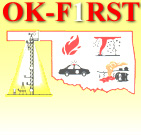|
Mesonet Product Descriptions
|
|
DEW POINT
OR
DEWPOINT TEMPERATURE
(TDEW)
|
|
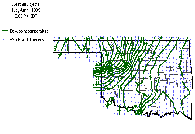
|
|
TYPE: Derived parameter
STANDARD UNITS:
Degrees Celsius
DESCRIPTION: Not measured, but computed from the
1.5-meter air temperature (TAIR) and relative humidity
(RELH).
SENSOR USED: None
NOTES: The
dewpoint temperature is a more revealing measure of the
moisture content in the air than is the relative humidity.
|
|
HEAT INDEX
(HEAT)
|
|
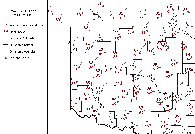
|
|
TYPE: Derived parameter
STANDARD UNITS: Degrees Celsius
DESCRIPTION: Not measured, but computed from the
1.5-meter air temperature (TAIR) and relative humidity
(RELH).
SENSOR USED: None
NOTES: The
heat index is used to provide information about possible
heat stress on the human body.
|
|
PRESSURE, ATMOSPHERIC
OR
BAROMETRIC PRESSURE
(PRES)
|
|
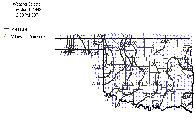
|
|
TYPE: Core
parameter
STANDARD UNITS:
Millibars
DESCRIPTION: The average station pressure during the
last 5-minute interval before the time designated on the
file (usually 00, 15, 30, or 45 minutes after the hour).
SENSOR USED: Barometer
NOTES: The
average pressure reading is accurate to 0.4 millibars for
temperatures between -30 deg and 50 deg Celsius, and for
pressures between 700 and 1100 millibars. Interestingly,
some pressure events smaller than 0.4 millibars, such as
gravity waves, can nevertheless be tracked with Mesonet
barometers. The key is to note trends and times of
occurrence visible in the data rather than count on
individual readings being precise to the nth degree.
Barometric pressure is not
corrected for the elevation of the station above sea level.
Caution must be used when calculating pressure gradients or
correcting station pressure to a reference height. For
theoretical wind calculations, an error is induced that is
proportional to the distance between the two stations.
However, changes in pressure over time at any given station
are very accurate measurements.
|
|
RAINFALL
(RAIN)
|
|
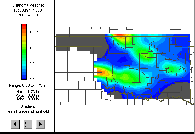
|
|
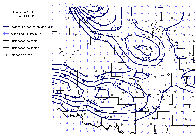
|
|
TYPE: Core
parameter
STANDARD UNITS: Millimeters of water per day
DESCRIPTION: The total amount of rainfall measured
since 0000 GMT [6 PM CST or 7 PM CDT] just above the ground;
it is measured in discrete tips of the bucket (approximately
0.01 inch per tip, or 0.254 millimeters).
SENSOR USED: Tipping-Bucket Rain Gauge
NOTES: Each
Mesonet observation contains a running accumulation of
rainfall since either 6 PM CST or 7 PM CDT. As each new
evening begins, the accumulated rainfall is reset to zero.
If the rainfall is very
light, the bucket may only tip once every half hour or so.
Thus, even if the rain is continuous, rainfall might be
recorded during every other 15-minute interval. If the
rainfall is very heavy, there is a strong likelihood that
rain has splashed out of the bucket. Thus, measurements
during heavy rainfall periods generally underestimate the
total amount of rainfall.
Unheated gauges were chosen
because of constraints on cost and power; the drawback is
that unheated gauges underestimate snow or freezing rain
totals. In addition, wet snow can clog the bucket while dry
snow often blows away. Therefore, do not rely on the gauge
observations during frozen precipitation events. Moreover,
once air temperatures rise above freezing, the water
equivalent of the melting precipitation is finally measured.
The result is a delayed measurement of winter precipitation.
|
|
RELATIVE HUMIDITY
(RELH)
|
|

|
|
TYPE: Core
parameter
STANDARD UNITS: Described as a percentage
DESCRIPTION: The average relative humidity at a
height of 1.5 meters above the ground during the last
5-minute interval before the time designated on the file
(usually 00, 15, 30, or 45 minutes after the hour).
SENSOR USED: Sorption Sensor
NOTES: Relative humidity changes when either
the moisture content of the air or the air temperature
changes. This sensor can detect relative humidity between 0
and 100%. The error for readings of 0 - 90% RH is 2%, while
readings of 90 - 100% RH have a 3% error. A dew-point sensor
of the chilled-mirror type was considered for the Mesonet,
but was less reliable for use in field conditions, more
expensive to purchase, and required more power.
|
|
SEA LEVEL PRESSURE
(PALT)
|
|
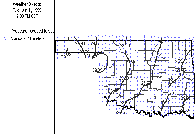
|
|
TYPE: Derived parameter
STANDARD UNITS: Millibars
DESCRIPTION: Not measured, but computed from the
barometric station pressure (PRES) and the station
elevation.
SENSOR USED: None
NOTES: Sea
level pressure should be used to compare pressures between
two stations at different elevations. Sea level pressure is
an approximation of the station's barometric pressure if the
station were located at sea level. Because pressure readings
can be approximated for sea level, differences in sea level
pressure between stations are related to differences in the
air mass above the two stations.
|
|
SOIL TEMPERATURE, UNDER BARE SOIL
(5 CM)
(TB05)
|
|
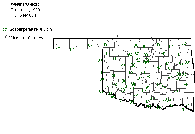
|
|
TYPE: Supplemental parameter
STANDARD UNITS: Degrees Celsius
DESCRIPTION: The average temperature during a
15-minute interval at a depth of 5 centimeters below the
ground; the surface under which the measurement is taken is
not vegetated.
SENSOR USED: Thermistor
NOTES: Similar to 10 centimeters soil
temperature under bare soil (TB10) but TB05 is typically
above the root level of crops.
The thermistor at 5
centimeters is able to detect the passage of the solar
panel's shadow on some days.
|
|
SOIL TEMPERATURE, UNDER BARE SOIL
(10 CM)
(TB10)
|
|
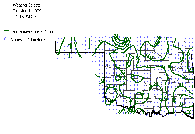
|
|
TYPE: Core
parameter
STANDARD UNITS: Degrees Celsius
DESCRIPTION: The average temperature at a depth of
10 centimeters below the ground during a 15-minute interval;
the surface under which the measurement is taken is not
vegetated.
SENSOR USED: Thermistor
NOTES: Bare
soil temperatures are useful for planting decisions under
conventional tillage regimes (the vast majority of Oklahoma
farms) and can be used to monitor soil conditions until a
complete crop canopy develops. This temperature reading also
is valuable during freezing rain and snow events when soil
temperatures play a critical role in determining how much
winter precipitation might accumulate.
|
|
SOIL TEMPERATURE, UNDER SOD (5 CM)
(TS05)
|
|
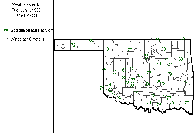
|
|
TYPE: Supplemental parameter
STANDARD UNITS: Degrees Celsius
DESCRIPTION: The average temperature during a
15-minute interval at a depth of 5 centimeters below the
ground; the surface under which the measurement is taken is
vegetated.
SENSOR USED: Thermistor
NOTES: Similar to 10 centimeters soil
temperature under sod (TS10) but TS05 is typically above the
root level of crops.
The thermistor at 5
centimeters is able to detect the passage of the solar
panel's shadow on some days.
|
|
SOIL TEMPERATURE, UNDER SOD (10 CM)
(TS10)
|
|
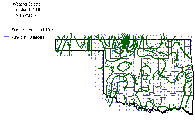
|
|
TYPE: Core
parameter
STANDARD UNITS: Degrees Celsius
DESCRIPTION: The average temperature at a depth of
10 centimeters below the ground during a 15-minute interval;
the surface under which the measurement is taken is
vegetated.
SENSOR USED: Thermistor
NOTES: This
soil temperature reading can be very important to the vast
acreage of rangeland across the state, as well as for
planting decisions under reduced or no-tillage systems, for
soil condition monitoring under a crop canopy, and for
industries such as turfgrass.
|
|
SOIL TEMPERATURE, UNDER SOD (30 CM)
(TS30)
|
|
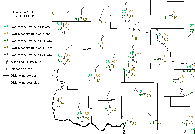
|
|
TYPE: Supplemental parameter
STANDARD UNITS: Degrees Celsius
DESCRIPTION: The average temperature during a
15-minute interval at a depth of 30 centimeters below the
ground.
SENSOR USED: Thermistor
NOTES:
|
|
SOLAR RADIATION
(SRAD)
|
|
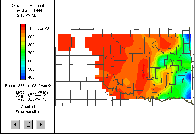
|
|
TYPE: Core
parameter
STANDARD UNITS: Watts per square meter
DESCRIPTION: The average amount of solar radiation
received at the sensor during the last 5-minute interval
before the time designated on the file (usually 00, 15, 30,
or 45 minutes after the hour).
SENSOR USED: Pyranometer
NOTES: A
tripod supports the sensor at a height of 1.8 m at the
southern end of the site, a position selected to avoid
reflections from the tower and to ensure that as few shadows
as possible fall upon the sensor.
The measurement of solar
radiation does not include radiation emitted from the earth
or atmosphere. However, the pyranometer will detect solar
radiation which is reflected downward in the atmosphere
(e.g., by molecules, clouds, etc.). Therefore, the
pyranometer can be used to determine if there are clouds,
but only during daylight hours. Note that the sensor points
upward and thus does not measure solar radiation reflected
upward from the ground.
|
|
TEMPERATURE, AIR
(1.5 M)
OR
AIR TEMPERATURE AT 1.5 METERS
(TAIR)
|
|

|
|
TYPE: Core
parameter
STANDARD UNITS: Degrees Celsius
DESCRIPTION: The average air temperature at a height
of 1.5 meters above the ground during the last 5-minute
interval before the time designated on the file (usually 00,
15, 30, or 45 minutes after the hour).
SENSOR USED: Thermistor
NOTES: This
sensor can have temperature errors of several degrees
Celsius when the wind is calm (less than 1 meter per second)
and radiation is strong (more than 800 Watts per square
meter). Radiation at high sun angles near 70 degrees seem to
induce the worst errors.
For design reasons, this
sensor is mounted within the same membrane shell as the
relative humidity sensor. As a result, the response time of
the TAIR is somewhat longer than would be the case for free
air exposure.
|
|
TEMPERATURE, AIR (9 M)
OR
AIR TEMPERATURE AT 9 METERS
(TA9M)
|
|

|
|
TYPE: Supplemental parameter
STANDARD UNITS: Degrees Celsius
DESCRIPTION: Same as air temperature at 1.5 meters
(TAIR) but faster response temperature sensor and positioned
at 9 meters.
SENSOR USED: Thermistor
NOTES: In
combination with the 1.5-meter air temperature, these data
have potential value in monitoring the stability of the
near-surface atmosphere, turbulence and temperature
inversions (including frost protection applications). This
thermistor has the same warm bias on calm, high-radiation
days as does the 1.5 meter thermistor.
|
|
WIND CHILL
(CHIL)
|
|
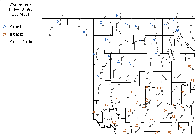
|
|
TYPE: Derived parameter
STANDARD UNITS: Degrees Celsius
DESCRIPTION: Not measured, but computed from the
1.5-meter air temperature (TAIR) and the wind speed at 10
meters (WSPD).
SENSOR USED: None
NOTES: Wind
chill represents the cooling effect on the human body of low
temperatures combined with wind.
|
|
WIND DIRECTION, AVERAGE
OR
VECTOR AVERAGE WIND DIRECTION
(WDIR)
|
|
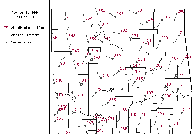
|
|
TYPE: Core
parameter
STANDARD UNITS: Described in degrees in a circle
(from North), where north is 0 degrees, east is 90 degrees,
south is 180 degrees, and west is 270 degrees.
DESCRIPTION: The vector average wind direction at a
height of 10 meters above the ground during the last
5-minute interval before the time designated on the file
(usually 00, 15, 30, or 45 minutes after the hour). Note:
wind direction always describes the direction from which the
wind is blowing and not toward which the wind is blowing.
SENSOR USED: Propeller Vane Anemometer
NOTES: When
WSPD is zero, WDIR and other 10-meter wind parameters are
set to zero.
|
|
WIND DIRECTION STANDARD DEVIATION
(WDSD)
|
TYPE: Core
parameter
STANDARD UNITS: Degrees from north
DESCRIPTION: The standard deviation of the wind
direction at 10 meters.
SENSOR USED: Pyranometer
NOTES: This
parameter is a measure of the steadiness of wind direction.
A small standard deviation indicates the wind was generally
blowing from the same direction; a large standard deviation
indicates significant changes in wind direction during the
last 5-minute interval before the time designated on the
file (usually 00, 15, 30, or 45 minutes after the hour). The
standard deviation may be large for either inclement weather
or relatively light winds.
|
|
WIND SPEED AT 2 METERS
(WS2M)
|
|

|
|
TYPE: Supplemental parameter
STANDARD UNITS: Meters per second
DESCRIPTION: Same as average wind speed for 10
meters except the anemometer is positioned at 2 meters.
SENSOR USED:
Cup Anemometer
NOTES: The
cup anemometer only counts the rotations of the sensor
caused by the speed of the wind; it does not measure wind
direction. This sensor is a three cup unit mounted at the
end of a short boom, and has a starting threshold of 0.5
meters per second. Its range is from 0.5 to 50 meters per
second and it can withstand gusts of 60 meters per second.
The 2-meter wind speed mainly is used for agricultural
purposes (e.g., to help estimate evapotranspiration of
moisture from the soil).
|
|
WIND SPEED, AVERAGE (10
M)
OR
AVERAGE WIND SPEED AT 10 METERS
(WSPD)
|
TYPE: Core
parameter
STANDARD UNITS: Meters per second
DESCRIPTION: The average wind speed without regard
to direction at a height of 10 meters above the ground
during the last 5-minute interval before the time designated
on the file (usually 00, 15, 30, or 45 minutes after the
hour).
SENSOR USED: Propeller Vane Anemometer
NOTES: The
average wind speed is independent of the wind direction
during the 5-minute averaging interval. The parameter is the
arithmetic average speed.
The propeller has a range
of 1 to 60 meters per second, and can withstand gusts of 100
meters per second. A wind speed of 1 meter per second is
necessary to start the propeller.
|
|
WIND SPEED, MAXIMUM
(WMAX)
|
|
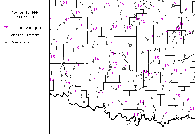
|
|
TYPE:Core
parameter
STANDARD UNITS: Meters per second
DESCRIPTION: The maximum (or peak) wind speed
observed during a 5-minute interval at a height of 10 meters
above ground; it is the largest value observed (3 second
average) during the 5 minute averaging interval.
SENSOR USED: Propeller Vane Anemometer
NOTES: This
parameter is independent of wind direction. The propeller
can withstand gusts of 100 meters per second.
|
|
WIND SPEED STANDARD DEVIATION
(WSSD)
|
TYPE: Core
parameter
STANDARD UNITS: Meters per second
DESCRIPTION: The standard deviation of the wind
speed at 10 meters.
SENSOR USED: Propeller Vane Anemometer
NOTES: This
parameter is a measure of the steadiness of wind speed. A
small standard deviation indicates the wind generally
blowing at the same speed; a large standard deviation
indicates significant changes in wind speed during the last
5-minute interval before the time designated on the file
(usually 00, 15, 30, or 45 minutes after the hour). The
standard deviation may be large for inclement weather.
|
|
WIND SPEED, VECTOR AVERAGE
OR
VECTOR AVERAGE WIND SPEED
(WVEC)
|
TYPE: Core
parameter
STANDARD UNITS: Meters per second
DESCRIPTION: The average wind velocity (speed and
direction accounted for) at a height of 10 meters above the
ground during the last 5-minute interval before the time
designated on the file (usually 00, 15, 30, or 45 minutes
after the hour).
SENSOR USED: Propeller Vane Anemometer
NOTES: This
is a vector average (i.e., the wind direction is
considered). If the wind is out of the north at 10 meters
per second for 2.5 minutes and then out of the south at 10
meters per second for 2.5 minutes, the average vector wind
velocity will be zero during that 5-minute period.
|
